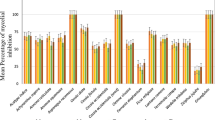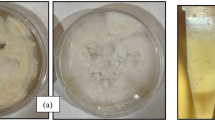Abstract
Strains of five dermatophyte species (Microsporum canis, Microsporum gypseum, Trichophyton mentagrophytes, Trichophyton rubrum and Trichophyton tonsurans) were selected for testing against Penicillium chrysogenum antifungal protein (PAF) and its combination with fluconazole (FCZ). Inhibition of microconidia germination and growth was detected with MICs of PAF ranging from 1.56 to 200 μg ml−1 when it was used alone, or at constant concentration (100 μg ml−1) in combination with FCZ at from 0.25 to 32 μg ml−1. The MICs for FCZ were found to be between 0.25 and 128 μg ml−1. PAF caused a fungicidal effect at 200 μg ml−1 and reduced growth at between 50 and 200 μg ml−1. Total growth inhibition with fungistatic activity was detected at 64 μg ml−1 of FCZ for M. gypseum, T. mentagrophytes, and T. tonsurans, and at 32 μg ml−1 FCZ for M. canis and T. rubrum. PAF and FCZ acted synergistically and/or additively on all of the tested fungi except M. gypseum, where no interactions were detected.

Similar content being viewed by others
Abbreviations
- ADD:
-
Additive effect
- FCZ:
-
Fluconazole
- FI:
-
Full inhibition
- IR:
-
Interaction ratio
- NI:
-
No interaction
- PAF:
-
Penicillium chrysogenum antifungal protein
- SY:
-
Synergism
References
Abecassis S, Roujeau J-C, Bocquet H, Copie-Bergman C, Radier C, Revuz J, Cosnes A (2004) Severe sialadenitis: a new complication of drug reaction with eosinophilia and systemic symptoms. J Am Acad Dermatol 51:827–830
Aksakal BA, Özsoy E, Arnavut Ö, Gürer MA (2003) Oral terbinafine-induced bullous pemphigoid. Ann Pharmacother 37:1625–1627
Bennett ML, Jorizzo JL, White WL (1999) Generalized pustular eruptions associated with oral terbinafine. Int J Dermatol 38:596–600
Fernández-Torres B, Carrillo AJ, Martin E, del Palaco A, Moore MK, Valverde A, Serrano M, Guarro J (2001) In vitro activities of 10 antifungal drugs against 508 dermatophyte strains. Antimicrob Agents Chemother 45:2524–2528
Fernández-Torres B, Cabanes FJ, Carrillo-Munoz AJ, Esteban A, Inza I, Abarca L, Guarro J (2002) Collaborative evaluation of optimal antifungal susceptibility testing conditions for dermatophytes. J Clin Microbiol 40:3999–4003
Galgóczy L, Papp T, Leiter É, Marx F, Pócsi I, Vágvölgyi C (2005) Sensitivity of different Zygomycetes to the Penicillium chrysogenum antifungal protein (PAF). J Basic Microbiol 45:136–141
Galgóczy L, Papp T, Lukács G, Leiter É, Pócsi I, Vágvölgyi C (2007) Interactions between statins and Penicillium chrysogenum antifungal protein (PAF) to inhibit the germination of sporangiospores of different sensitive Zygomycetes. FEMS Microbiol Lett 207:109–115
Ghannoum MA, Chaturvedi V, Espinel-Ingroff A, Pfaller MA, Rinaldi MG, Lee-Yang W, Warnock DW (2004) Intra- and interlaboratory study of a method for testing the antifungal susceptibilities of dermatophytes. J Clin Microbiol 42:2977–2979
Ghannoum M, Isham N, Sheehan D (2006a) Voriconazole susceptibilities of dermatophyte isolates obtained from a worldwide tinea capitis clinical trial. J Clin Microbiol 44:2579–2581
Ghannoum MA, Arthington-Skaggs B, Chaturvedi V, Espinel-Ingroff A, Pfaller MA, Rennie R, Rinaldi MG, Walsh TJ (2006b) Interlaboratory study of quality control isolates for a broth microdilution method (Modified CLSI M38-A) for testing susceptibilities of dermatophytes to antifungals. J Clin Microbiol 44:4354–4356
Gupta AK, Porges AJ (1998) Hypersensitivity syndrome reaction to oral terbinafine. Aust J Dermatol 39:171–172
Gupta AK, Lynde CW, Lauzon GJ, Mehlmauer MA, Braddock SW, Miller CA, Del Rosso JQ, Shear NH (1998) Cutaneous adverse effects associated with terbinafine therapy: 10 case reports and a review of the literature. Br J Dermatol 138:529–532
Hall AP, Tate B (2000) Acute generalized exanthematous pustulosis associated with oral terbinafine. Aust J Dermatol 41:42–45
Jacobi U, Engel K, Patzelt A, Worm M, Sterry W, Lademann J (2007) Penetration of pollen proteins into the skin. Skin Pharmacol Physiol 20:297–304
Jessup CJ, Warner J, Isham N, Hasan I, Ghannoum MA (2000) Antifungal susceptibility testing of dermatophytes: establishing a medium for inducing conidial growth and evaluation of susceptibility of clinical isolates. J Clin Microbiol 38:341–344
Kaiserer L, Oberparleiter C, Weiler-Görz R, Burgstaller W, Leiter É, Marx F (2003) Characterization of the Penicillium chrysogenum antifungal protein PAF. Arch Microbiol 180:204–210
Kim B-S, Jang H-S, Jwa S-W, Jang B-S, Kim M-B, Oh C-K, Kwon Y-W, Kwon K-S (2007) Generalized pustular psoriasis and hepatic dysfunction associated with oral terbinafine therapy. J Korean Med Sci 22:167–169
Leiter É, Szappanos H, Oberparleiter C, Kaiserer L, Csernoh L, Pusztahelyi T, Emri T, Pócsi I, Salvenmoser W, Marx F (2005) Antifungal protein PAF severely affects the integrity of the plasma membrane of Aspergillus nidulans and induces an apoptosis-like phenotype. Antimicrob Agents Chemother 49:2445–2453
Marx F (2004) Small, basic antifungal proteins secreted from filamentous ascomycetes: a comparative study regarding expression, structure, function and potential application. Appl Microbiol Biotechnol 65:133–142
Marx F, Haas H, Reindl M, Stoffler G, Lottspeich F, Redl B (1995) Cloning, structural organization and regulation of expression of the Penicillium chrysogenum paf gene encoding an abundantly secreted protein with antifungal activity. Gene 167:167–171
Marx F, Binder U, Leiter É, Pócsi I (2007) The Penicillium chrysogenum antifungal protein PAF, a promising tool for the development of new antifungal therapies and fungal cell biology studies. Cell Mol Life Sci 65:445–454
McKellar G, Porter D, Burden D (2004) Terbinafine as a cause of cutaneous lupus erythematosus. Rheumatology 43:249
Moreno AB, del Pozo ÁM, Borja M, San Segudo B (2003) Activity of the antifungal protein from Aspergillus giganteus against Botrytis cinerea. Phytopathology 93:1344–1353
Odds FC, Brown AJP, Gow NAR (2003) Antifungal agents: mechanisms of action. Trends Microbiol 11:272–279
Rogalski C, Hürlimann A, Burg G, Wüthrich B, Kempf W (2001) Drug reaction to terbinafine simulating an acute generalized exanthematous pustulosis. Hautarzt 52:444–448
Santos DA, Hamdan JS (2005) Evaluation of broth microdilution antifungal susceptibility testing conditions for Trichophyton rubrum. J Clin Microbiol 43:1917–1920
Santos DA, Barros MES, Hamdan JS (2006) Establishing a method of inoculum preparation for susceptibility testing of Trichophyton rubrum and Trichophyton mentagrophytes. J Clin Microbiol 44:98–101
Schopf R, Hettler O, Bräutigam M, Weidinger G, Kaben U, Mayser P, Res V (1999) Efficacy and tolerability of terbinafine 1% topical solution used for 1 week compared with 4 weeks clotrimazole 1% topical solution in the treatment of interdigital tinea pedis: a randomized, double-blind, multi-centre, 8-week clinical trial. Mycoses 42:415–420
Szappanos H, Szigeti GyP, Pál B, Rusznák Z, Szűcs G, Rajnavölgyi É, Balla J, Balla G, Nagy E, Leiter É, Pócsi I, Marx F, Csernoch L (2005) The Penicillium chrysogenum-derived antifungal peptide shows no toxic effects on mammalian cells in the intended therapeutic concentration. Naunyn-Schmiedebergs Arch Pharmacol 371:122–132
van Puijenbroek EP, Egberts AC, Meyboom RH, Leufkens HG (2001) Association between terbinafine and arthralgia, fever and urticaria: symptoms or syndrome? Pharmacoepidemiol Drug Saf 10:135–142
Villars V, Jones TC (1989) Clinical efficacy and tolerability of terbinafine (Lamisil)-a new topical and systemic fungicidal drug for treatment of dermatomycoses. Clin Exp Dermatol 14:124–127
Weitzman I, Summerbell RC (1995) The dermatophytes. Clin Microbiol Rev 8:240–259
Wildfeuer A, Faergemann J, Laufen H, Pfaff G, Zimmermann T, Seidl HP, Lach P (1994) Bioavailability of fluconazole in the skin after oral medication. Mycoses 37:127–130
Acknowledgements
I.P. was supported by GENOMNANOTECH-DEBRET (RET-06/2004). The financial support received from the Öveges József Program of the Hungarian National Office for Research and Technology (grant reference numbers OMFB 01501/2006 and 01528/2006) is also gratefully acknowledged. T.P. holds a János Bolyai Research Scholarship from the Hungarian Academy of Sciences. This research was also supported in part by ETT 214/2006.
Author information
Authors and Affiliations
Corresponding author
Rights and permissions
About this article
Cite this article
Galgóczy, L., Papp, T., Pócsi, I. et al. In vitro activity of Penicillium chrysogenum antifungal protein (PAF) and its combination with fluconazole against different dermatophytes. Antonie van Leeuwenhoek 94, 463–470 (2008). https://doi.org/10.1007/s10482-008-9263-x
Received:
Accepted:
Published:
Issue Date:
DOI: https://doi.org/10.1007/s10482-008-9263-x




